Report on Change Management Implementation, Commitment, and Challenges
VerifiedAdded on 2022/12/22
|12
|2387
|50
Report
AI Summary
This report critically assesses the implementation of change management within a business environment, focusing on the challenges of gaining employee commitment. It explores Kotter's eight-step change model and other strategies for organizational transformation. The report identifies key challenges, such as lack of communication and employee demotivation, while also suggesting methods to verify commitment through feedback mechanisms. Furthermore, it examines the importance of employee involvement and various interventions to sustain change momentum, including diagnostic activities, team building, and clear accountability. The report concludes by emphasizing the significance of change management in fostering consistent growth and adaptability within an organization, offering a comprehensive analysis of change management implementation, commitment, and challenges for effective leadership.
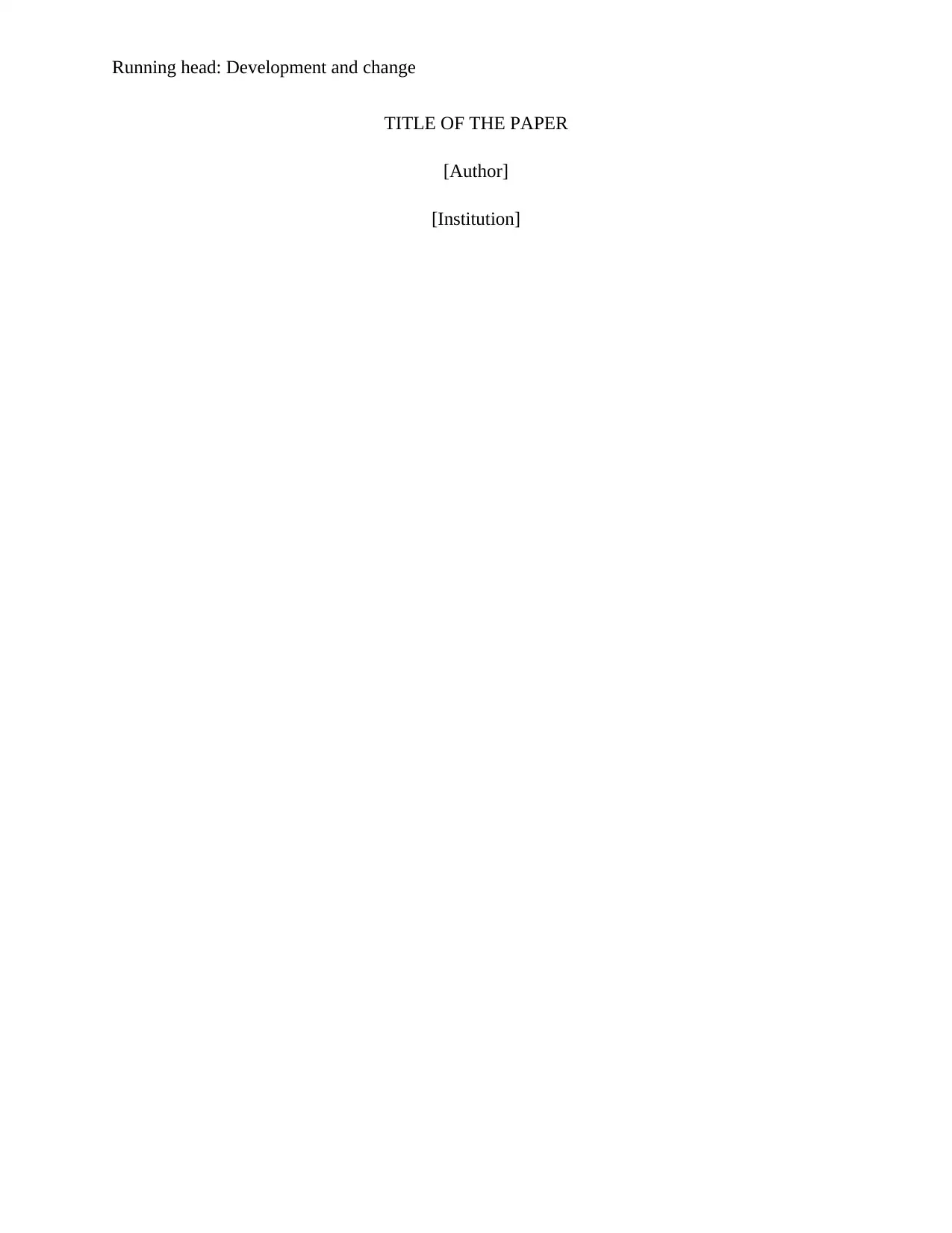
Running head: Development and change
TITLE OF THE PAPER
[Author]
[Institution]
TITLE OF THE PAPER
[Author]
[Institution]
Paraphrase This Document
Need a fresh take? Get an instant paraphrase of this document with our AI Paraphraser
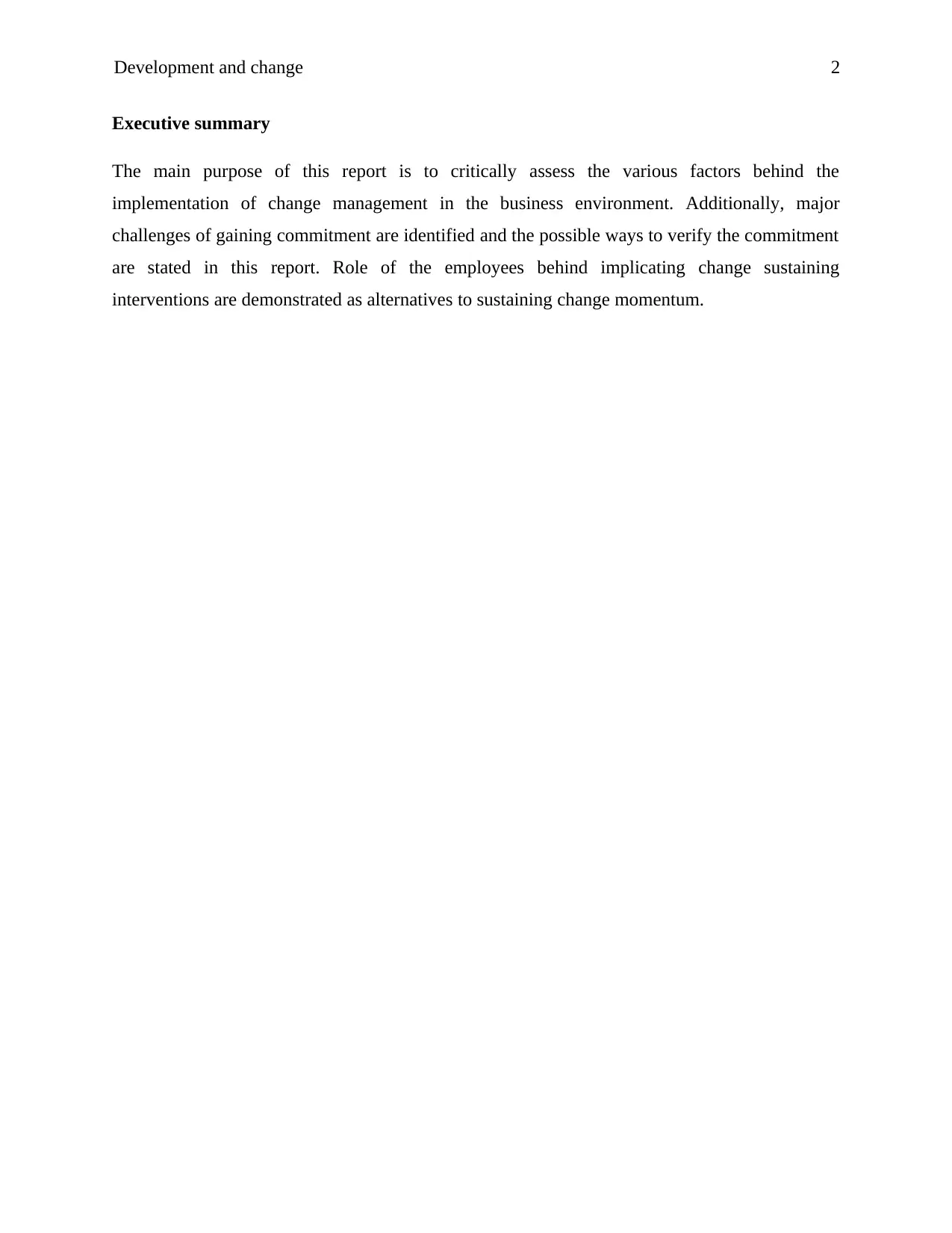
Development and change 2
Executive summary
The main purpose of this report is to critically assess the various factors behind the
implementation of change management in the business environment. Additionally, major
challenges of gaining commitment are identified and the possible ways to verify the commitment
are stated in this report. Role of the employees behind implicating change sustaining
interventions are demonstrated as alternatives to sustaining change momentum.
Executive summary
The main purpose of this report is to critically assess the various factors behind the
implementation of change management in the business environment. Additionally, major
challenges of gaining commitment are identified and the possible ways to verify the commitment
are stated in this report. Role of the employees behind implicating change sustaining
interventions are demonstrated as alternatives to sustaining change momentum.
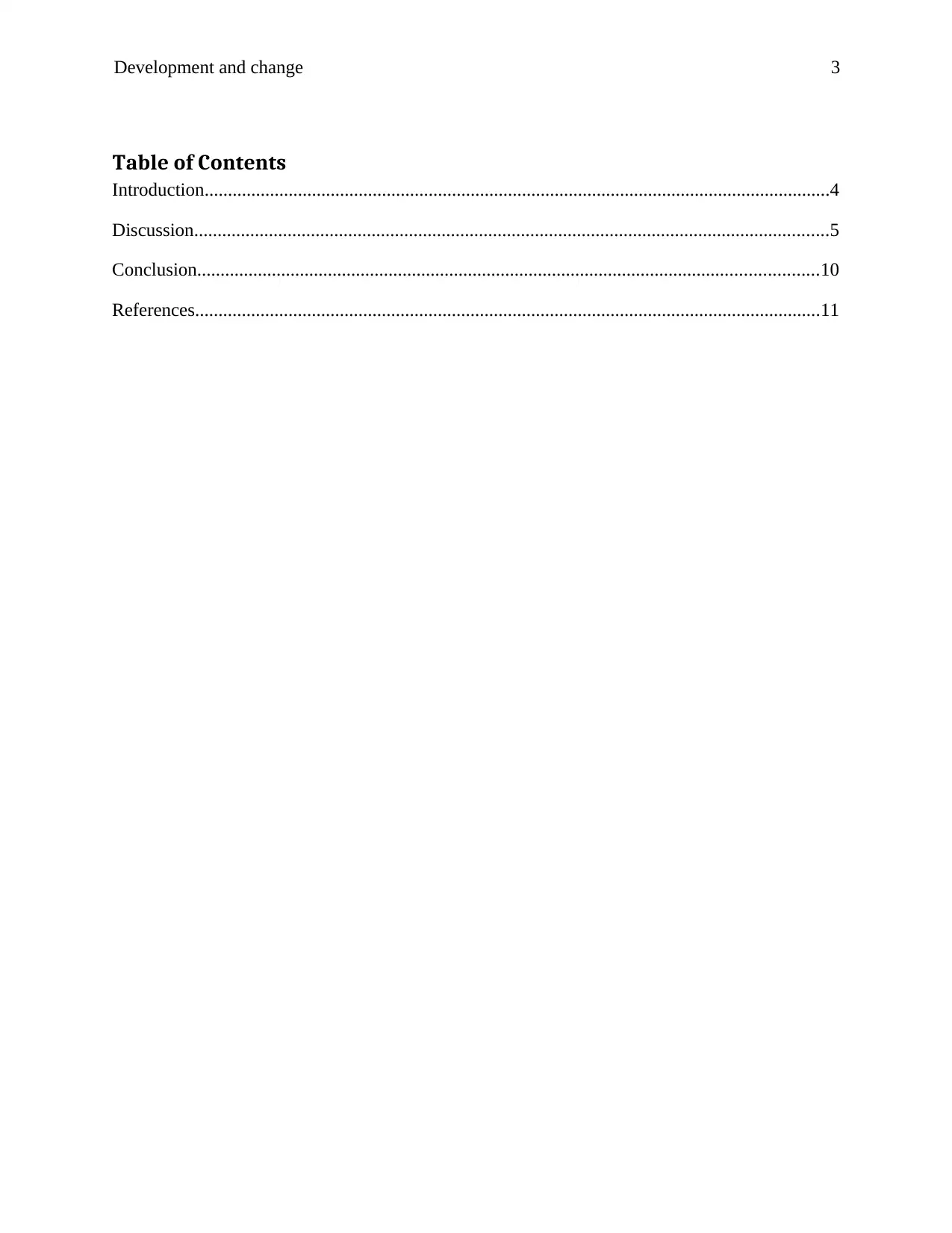
Development and change 3
Table of Contents
Introduction......................................................................................................................................4
Discussion........................................................................................................................................5
Conclusion.....................................................................................................................................10
References......................................................................................................................................11
Table of Contents
Introduction......................................................................................................................................4
Discussion........................................................................................................................................5
Conclusion.....................................................................................................................................10
References......................................................................................................................................11
⊘ This is a preview!⊘
Do you want full access?
Subscribe today to unlock all pages.

Trusted by 1+ million students worldwide
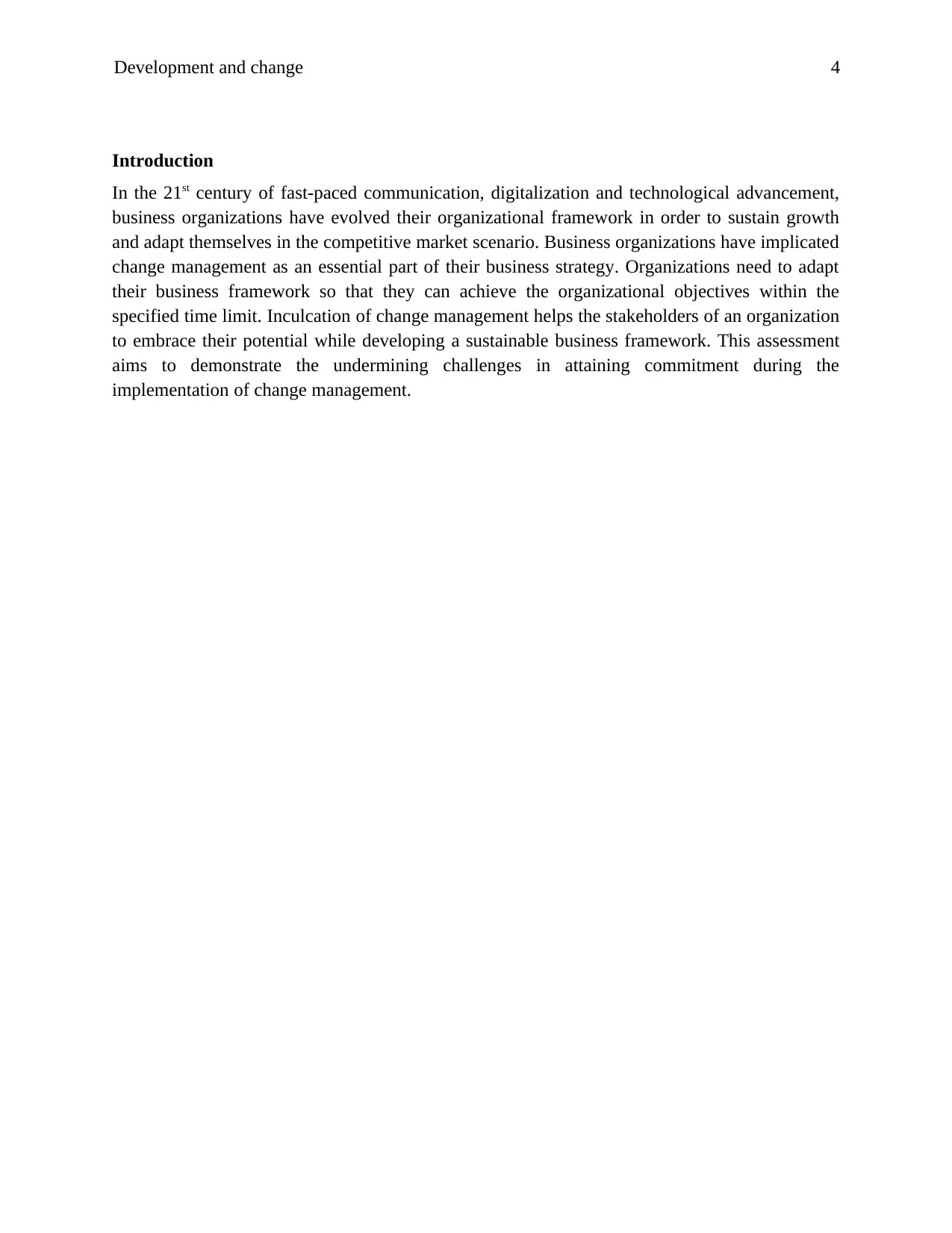
Development and change 4
Introduction
In the 21st century of fast-paced communication, digitalization and technological advancement,
business organizations have evolved their organizational framework in order to sustain growth
and adapt themselves in the competitive market scenario. Business organizations have implicated
change management as an essential part of their business strategy. Organizations need to adapt
their business framework so that they can achieve the organizational objectives within the
specified time limit. Inculcation of change management helps the stakeholders of an organization
to embrace their potential while developing a sustainable business framework. This assessment
aims to demonstrate the undermining challenges in attaining commitment during the
implementation of change management.
Introduction
In the 21st century of fast-paced communication, digitalization and technological advancement,
business organizations have evolved their organizational framework in order to sustain growth
and adapt themselves in the competitive market scenario. Business organizations have implicated
change management as an essential part of their business strategy. Organizations need to adapt
their business framework so that they can achieve the organizational objectives within the
specified time limit. Inculcation of change management helps the stakeholders of an organization
to embrace their potential while developing a sustainable business framework. This assessment
aims to demonstrate the undermining challenges in attaining commitment during the
implementation of change management.
Paraphrase This Document
Need a fresh take? Get an instant paraphrase of this document with our AI Paraphraser
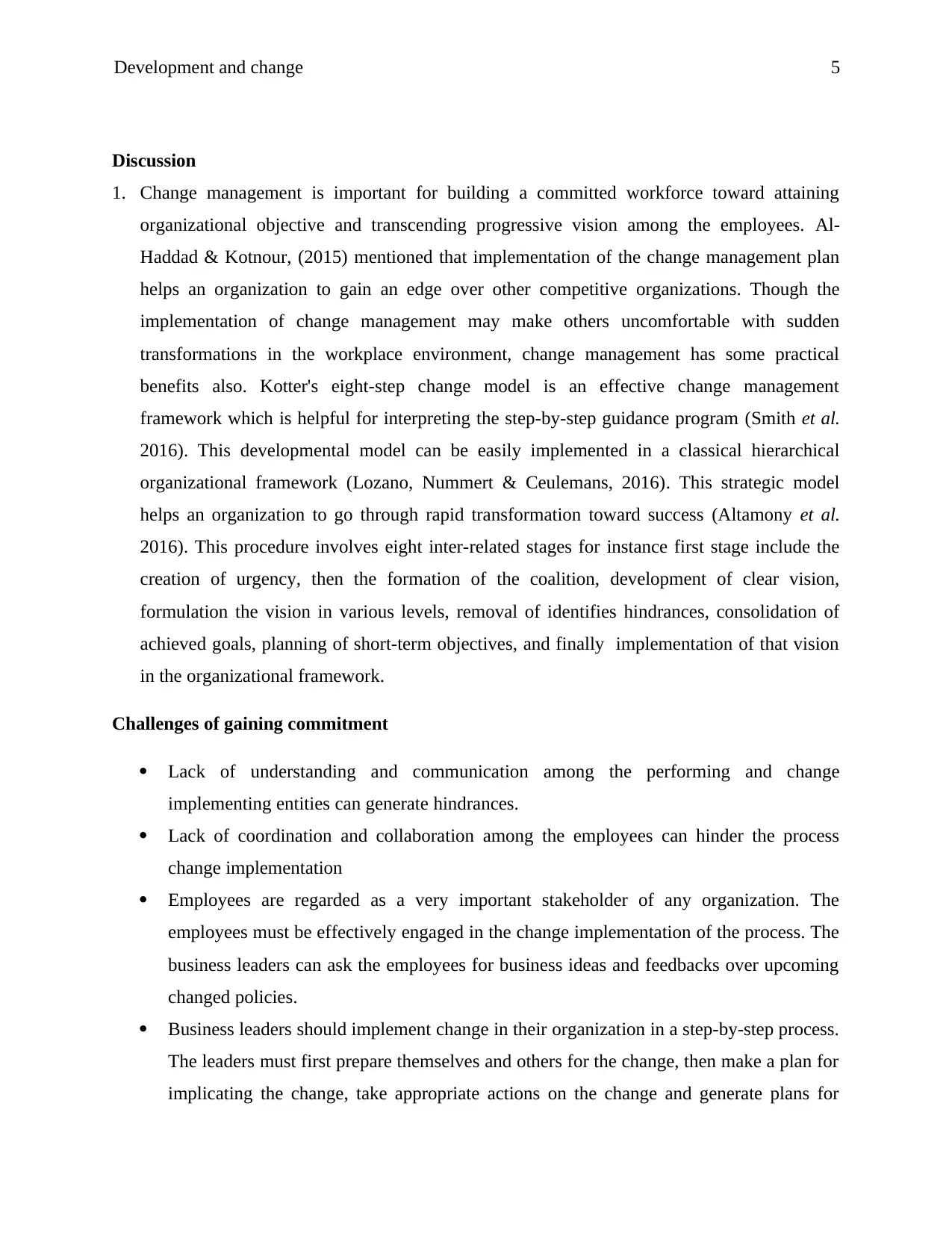
Development and change 5
Discussion
1. Change management is important for building a committed workforce toward attaining
organizational objective and transcending progressive vision among the employees. Al-
Haddad & Kotnour, (2015) mentioned that implementation of the change management plan
helps an organization to gain an edge over other competitive organizations. Though the
implementation of change management may make others uncomfortable with sudden
transformations in the workplace environment, change management has some practical
benefits also. Kotter's eight-step change model is an effective change management
framework which is helpful for interpreting the step-by-step guidance program (Smith et al.
2016). This developmental model can be easily implemented in a classical hierarchical
organizational framework (Lozano, Nummert & Ceulemans, 2016). This strategic model
helps an organization to go through rapid transformation toward success (Altamony et al.
2016). This procedure involves eight inter-related stages for instance first stage include the
creation of urgency, then the formation of the coalition, development of clear vision,
formulation the vision in various levels, removal of identifies hindrances, consolidation of
achieved goals, planning of short-term objectives, and finally implementation of that vision
in the organizational framework.
Challenges of gaining commitment
Lack of understanding and communication among the performing and change
implementing entities can generate hindrances.
Lack of coordination and collaboration among the employees can hinder the process
change implementation
Employees are regarded as a very important stakeholder of any organization. The
employees must be effectively engaged in the change implementation of the process. The
business leaders can ask the employees for business ideas and feedbacks over upcoming
changed policies.
Business leaders should implement change in their organization in a step-by-step process.
The leaders must first prepare themselves and others for the change, then make a plan for
implicating the change, take appropriate actions on the change and generate plans for
Discussion
1. Change management is important for building a committed workforce toward attaining
organizational objective and transcending progressive vision among the employees. Al-
Haddad & Kotnour, (2015) mentioned that implementation of the change management plan
helps an organization to gain an edge over other competitive organizations. Though the
implementation of change management may make others uncomfortable with sudden
transformations in the workplace environment, change management has some practical
benefits also. Kotter's eight-step change model is an effective change management
framework which is helpful for interpreting the step-by-step guidance program (Smith et al.
2016). This developmental model can be easily implemented in a classical hierarchical
organizational framework (Lozano, Nummert & Ceulemans, 2016). This strategic model
helps an organization to go through rapid transformation toward success (Altamony et al.
2016). This procedure involves eight inter-related stages for instance first stage include the
creation of urgency, then the formation of the coalition, development of clear vision,
formulation the vision in various levels, removal of identifies hindrances, consolidation of
achieved goals, planning of short-term objectives, and finally implementation of that vision
in the organizational framework.
Challenges of gaining commitment
Lack of understanding and communication among the performing and change
implementing entities can generate hindrances.
Lack of coordination and collaboration among the employees can hinder the process
change implementation
Employees are regarded as a very important stakeholder of any organization. The
employees must be effectively engaged in the change implementation of the process. The
business leaders can ask the employees for business ideas and feedbacks over upcoming
changed policies.
Business leaders should implement change in their organization in a step-by-step process.
The leaders must first prepare themselves and others for the change, then make a plan for
implicating the change, take appropriate actions on the change and generate plans for
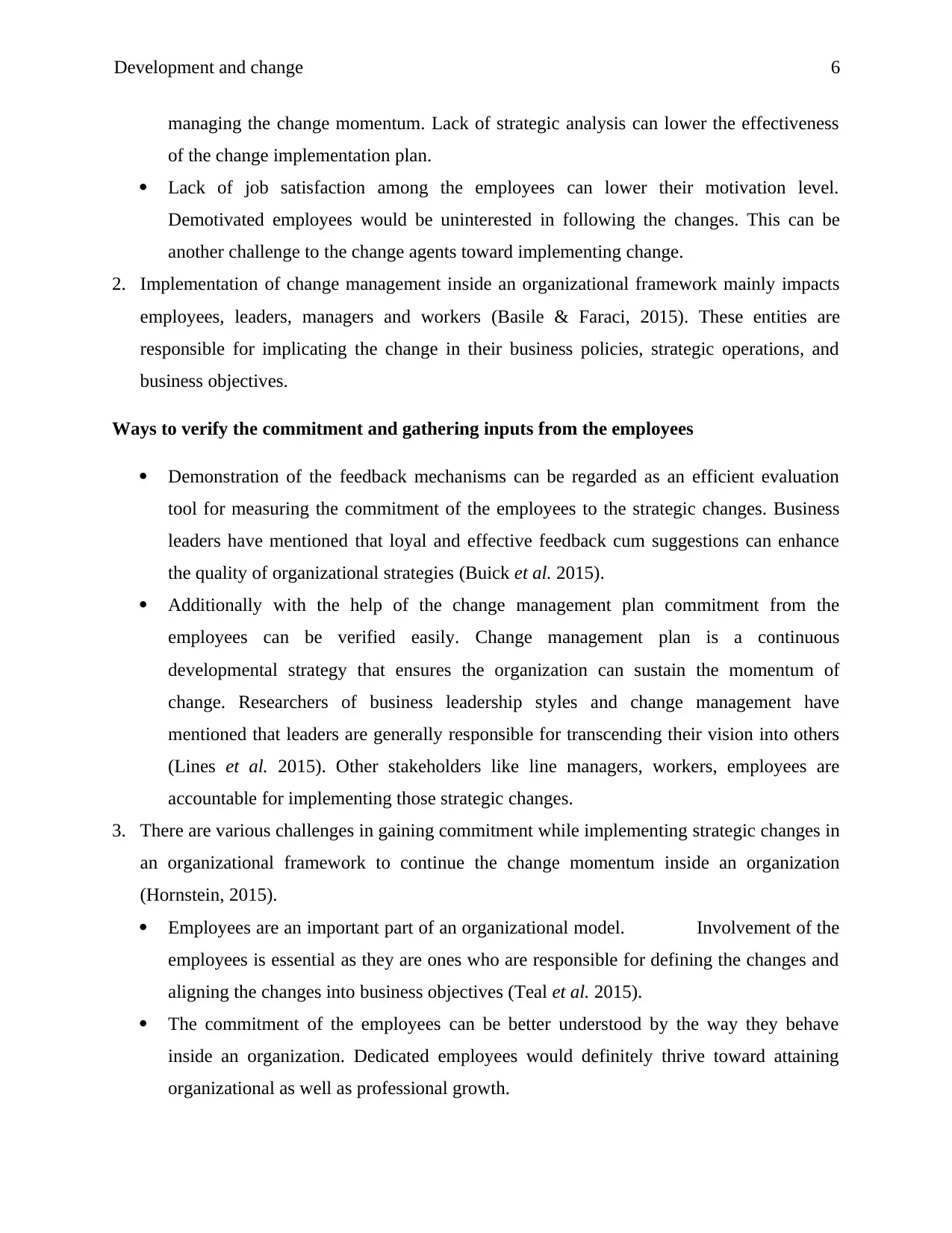
Development and change 6
managing the change momentum. Lack of strategic analysis can lower the effectiveness
of the change implementation plan.
Lack of job satisfaction among the employees can lower their motivation level.
Demotivated employees would be uninterested in following the changes. This can be
another challenge to the change agents toward implementing change.
2. Implementation of change management inside an organizational framework mainly impacts
employees, leaders, managers and workers (Basile & Faraci, 2015). These entities are
responsible for implicating the change in their business policies, strategic operations, and
business objectives.
Ways to verify the commitment and gathering inputs from the employees
Demonstration of the feedback mechanisms can be regarded as an efficient evaluation
tool for measuring the commitment of the employees to the strategic changes. Business
leaders have mentioned that loyal and effective feedback cum suggestions can enhance
the quality of organizational strategies (Buick et al. 2015).
Additionally with the help of the change management plan commitment from the
employees can be verified easily. Change management plan is a continuous
developmental strategy that ensures the organization can sustain the momentum of
change. Researchers of business leadership styles and change management have
mentioned that leaders are generally responsible for transcending their vision into others
(Lines et al. 2015). Other stakeholders like line managers, workers, employees are
accountable for implementing those strategic changes.
3. There are various challenges in gaining commitment while implementing strategic changes in
an organizational framework to continue the change momentum inside an organization
(Hornstein, 2015).
Employees are an important part of an organizational model. Involvement of the
employees is essential as they are ones who are responsible for defining the changes and
aligning the changes into business objectives (Teal et al. 2015).
The commitment of the employees can be better understood by the way they behave
inside an organization. Dedicated employees would definitely thrive toward attaining
organizational as well as professional growth.
managing the change momentum. Lack of strategic analysis can lower the effectiveness
of the change implementation plan.
Lack of job satisfaction among the employees can lower their motivation level.
Demotivated employees would be uninterested in following the changes. This can be
another challenge to the change agents toward implementing change.
2. Implementation of change management inside an organizational framework mainly impacts
employees, leaders, managers and workers (Basile & Faraci, 2015). These entities are
responsible for implicating the change in their business policies, strategic operations, and
business objectives.
Ways to verify the commitment and gathering inputs from the employees
Demonstration of the feedback mechanisms can be regarded as an efficient evaluation
tool for measuring the commitment of the employees to the strategic changes. Business
leaders have mentioned that loyal and effective feedback cum suggestions can enhance
the quality of organizational strategies (Buick et al. 2015).
Additionally with the help of the change management plan commitment from the
employees can be verified easily. Change management plan is a continuous
developmental strategy that ensures the organization can sustain the momentum of
change. Researchers of business leadership styles and change management have
mentioned that leaders are generally responsible for transcending their vision into others
(Lines et al. 2015). Other stakeholders like line managers, workers, employees are
accountable for implementing those strategic changes.
3. There are various challenges in gaining commitment while implementing strategic changes in
an organizational framework to continue the change momentum inside an organization
(Hornstein, 2015).
Employees are an important part of an organizational model. Involvement of the
employees is essential as they are ones who are responsible for defining the changes and
aligning the changes into business objectives (Teal et al. 2015).
The commitment of the employees can be better understood by the way they behave
inside an organization. Dedicated employees would definitely thrive toward attaining
organizational as well as professional growth.
⊘ This is a preview!⊘
Do you want full access?
Subscribe today to unlock all pages.

Trusted by 1+ million students worldwide
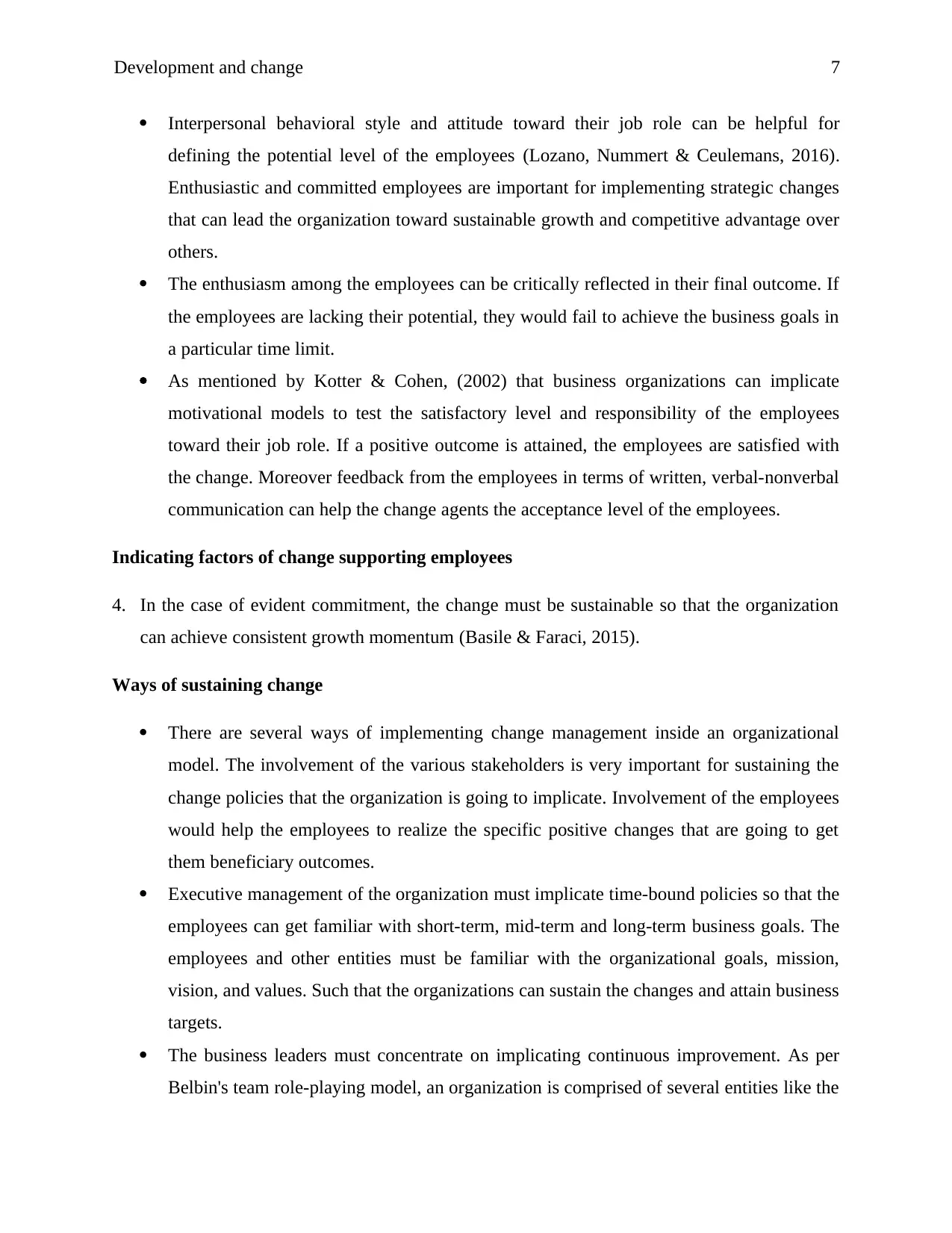
Development and change 7
Interpersonal behavioral style and attitude toward their job role can be helpful for
defining the potential level of the employees (Lozano, Nummert & Ceulemans, 2016).
Enthusiastic and committed employees are important for implementing strategic changes
that can lead the organization toward sustainable growth and competitive advantage over
others.
The enthusiasm among the employees can be critically reflected in their final outcome. If
the employees are lacking their potential, they would fail to achieve the business goals in
a particular time limit.
As mentioned by Kotter & Cohen, (2002) that business organizations can implicate
motivational models to test the satisfactory level and responsibility of the employees
toward their job role. If a positive outcome is attained, the employees are satisfied with
the change. Moreover feedback from the employees in terms of written, verbal-nonverbal
communication can help the change agents the acceptance level of the employees.
Indicating factors of change supporting employees
4. In the case of evident commitment, the change must be sustainable so that the organization
can achieve consistent growth momentum (Basile & Faraci, 2015).
Ways of sustaining change
There are several ways of implementing change management inside an organizational
model. The involvement of the various stakeholders is very important for sustaining the
change policies that the organization is going to implicate. Involvement of the employees
would help the employees to realize the specific positive changes that are going to get
them beneficiary outcomes.
Executive management of the organization must implicate time-bound policies so that the
employees can get familiar with short-term, mid-term and long-term business goals. The
employees and other entities must be familiar with the organizational goals, mission,
vision, and values. Such that the organizations can sustain the changes and attain business
targets.
The business leaders must concentrate on implicating continuous improvement. As per
Belbin's team role-playing model, an organization is comprised of several entities like the
Interpersonal behavioral style and attitude toward their job role can be helpful for
defining the potential level of the employees (Lozano, Nummert & Ceulemans, 2016).
Enthusiastic and committed employees are important for implementing strategic changes
that can lead the organization toward sustainable growth and competitive advantage over
others.
The enthusiasm among the employees can be critically reflected in their final outcome. If
the employees are lacking their potential, they would fail to achieve the business goals in
a particular time limit.
As mentioned by Kotter & Cohen, (2002) that business organizations can implicate
motivational models to test the satisfactory level and responsibility of the employees
toward their job role. If a positive outcome is attained, the employees are satisfied with
the change. Moreover feedback from the employees in terms of written, verbal-nonverbal
communication can help the change agents the acceptance level of the employees.
Indicating factors of change supporting employees
4. In the case of evident commitment, the change must be sustainable so that the organization
can achieve consistent growth momentum (Basile & Faraci, 2015).
Ways of sustaining change
There are several ways of implementing change management inside an organizational
model. The involvement of the various stakeholders is very important for sustaining the
change policies that the organization is going to implicate. Involvement of the employees
would help the employees to realize the specific positive changes that are going to get
them beneficiary outcomes.
Executive management of the organization must implicate time-bound policies so that the
employees can get familiar with short-term, mid-term and long-term business goals. The
employees and other entities must be familiar with the organizational goals, mission,
vision, and values. Such that the organizations can sustain the changes and attain business
targets.
The business leaders must concentrate on implicating continuous improvement. As per
Belbin's team role-playing model, an organization is comprised of several entities like the
Paraphrase This Document
Need a fresh take? Get an instant paraphrase of this document with our AI Paraphraser
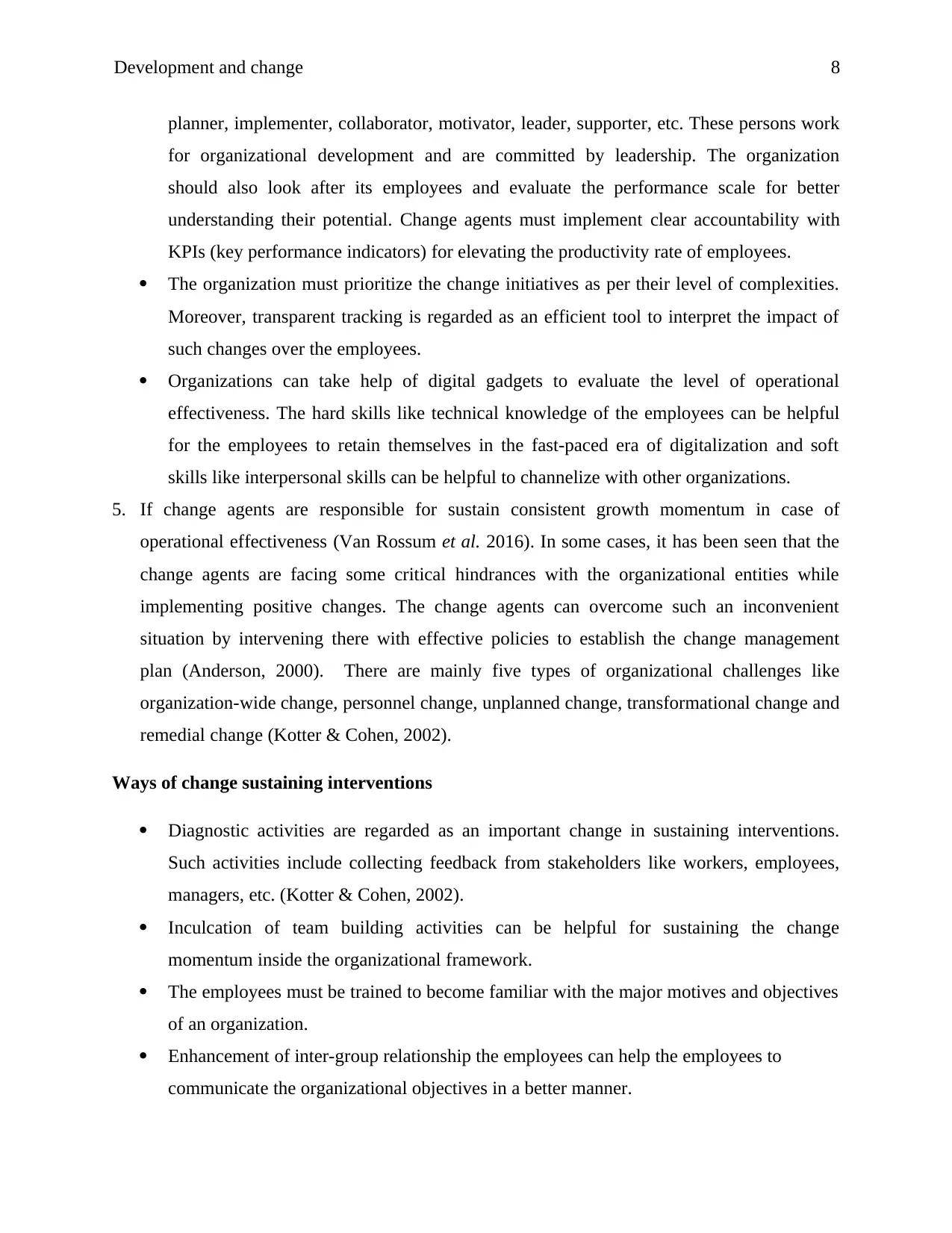
Development and change 8
planner, implementer, collaborator, motivator, leader, supporter, etc. These persons work
for organizational development and are committed by leadership. The organization
should also look after its employees and evaluate the performance scale for better
understanding their potential. Change agents must implement clear accountability with
KPIs (key performance indicators) for elevating the productivity rate of employees.
The organization must prioritize the change initiatives as per their level of complexities.
Moreover, transparent tracking is regarded as an efficient tool to interpret the impact of
such changes over the employees.
Organizations can take help of digital gadgets to evaluate the level of operational
effectiveness. The hard skills like technical knowledge of the employees can be helpful
for the employees to retain themselves in the fast-paced era of digitalization and soft
skills like interpersonal skills can be helpful to channelize with other organizations.
5. If change agents are responsible for sustain consistent growth momentum in case of
operational effectiveness (Van Rossum et al. 2016). In some cases, it has been seen that the
change agents are facing some critical hindrances with the organizational entities while
implementing positive changes. The change agents can overcome such an inconvenient
situation by intervening there with effective policies to establish the change management
plan (Anderson, 2000). There are mainly five types of organizational challenges like
organization-wide change, personnel change, unplanned change, transformational change and
remedial change (Kotter & Cohen, 2002).
Ways of change sustaining interventions
Diagnostic activities are regarded as an important change in sustaining interventions.
Such activities include collecting feedback from stakeholders like workers, employees,
managers, etc. (Kotter & Cohen, 2002).
Inculcation of team building activities can be helpful for sustaining the change
momentum inside the organizational framework.
The employees must be trained to become familiar with the major motives and objectives
of an organization.
Enhancement of inter-group relationship the employees can help the employees to
communicate the organizational objectives in a better manner.
planner, implementer, collaborator, motivator, leader, supporter, etc. These persons work
for organizational development and are committed by leadership. The organization
should also look after its employees and evaluate the performance scale for better
understanding their potential. Change agents must implement clear accountability with
KPIs (key performance indicators) for elevating the productivity rate of employees.
The organization must prioritize the change initiatives as per their level of complexities.
Moreover, transparent tracking is regarded as an efficient tool to interpret the impact of
such changes over the employees.
Organizations can take help of digital gadgets to evaluate the level of operational
effectiveness. The hard skills like technical knowledge of the employees can be helpful
for the employees to retain themselves in the fast-paced era of digitalization and soft
skills like interpersonal skills can be helpful to channelize with other organizations.
5. If change agents are responsible for sustain consistent growth momentum in case of
operational effectiveness (Van Rossum et al. 2016). In some cases, it has been seen that the
change agents are facing some critical hindrances with the organizational entities while
implementing positive changes. The change agents can overcome such an inconvenient
situation by intervening there with effective policies to establish the change management
plan (Anderson, 2000). There are mainly five types of organizational challenges like
organization-wide change, personnel change, unplanned change, transformational change and
remedial change (Kotter & Cohen, 2002).
Ways of change sustaining interventions
Diagnostic activities are regarded as an important change in sustaining interventions.
Such activities include collecting feedback from stakeholders like workers, employees,
managers, etc. (Kotter & Cohen, 2002).
Inculcation of team building activities can be helpful for sustaining the change
momentum inside the organizational framework.
The employees must be trained to become familiar with the major motives and objectives
of an organization.
Enhancement of inter-group relationship the employees can help the employees to
communicate the organizational objectives in a better manner.
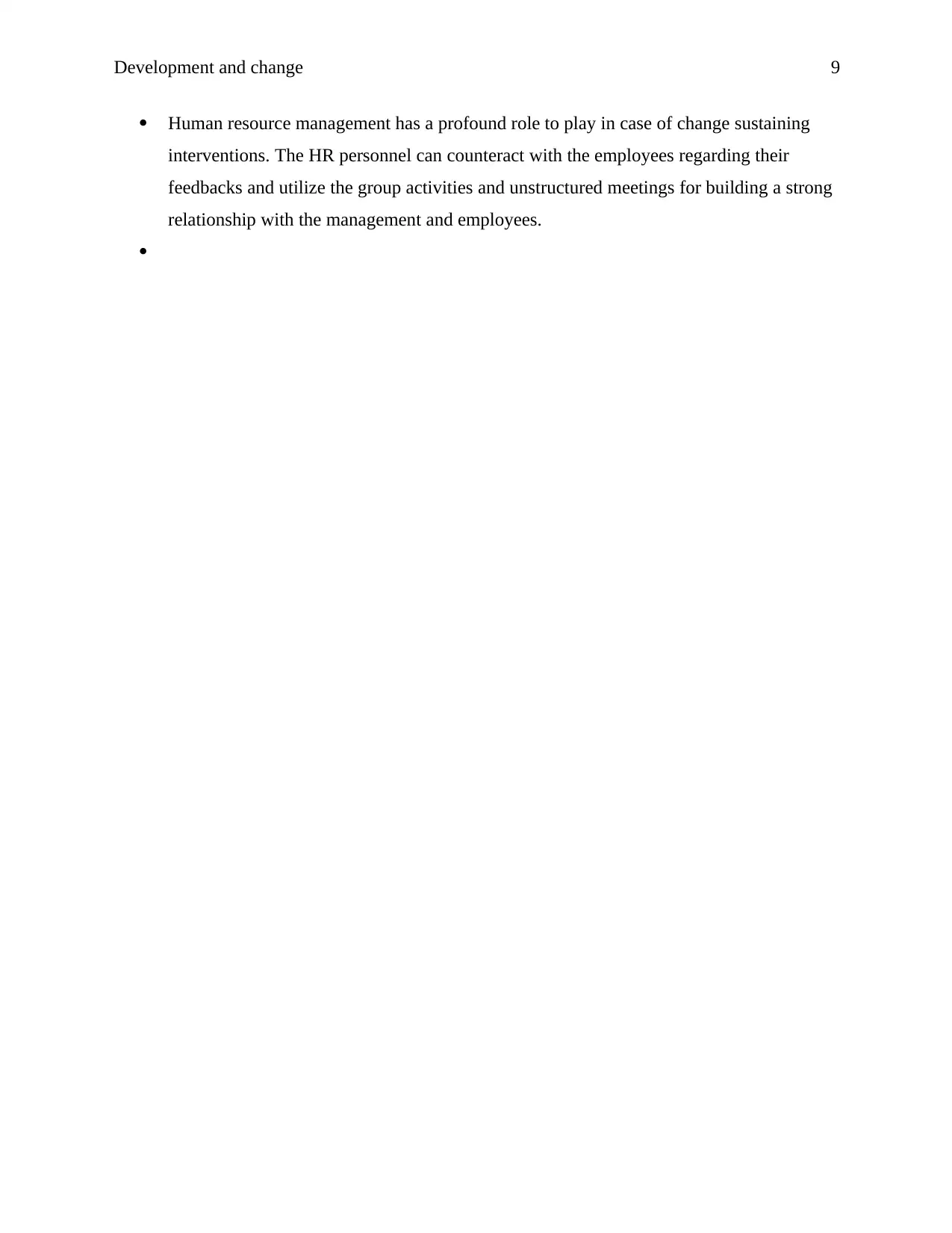
Development and change 9
Human resource management has a profound role to play in case of change sustaining
interventions. The HR personnel can counteract with the employees regarding their
feedbacks and utilize the group activities and unstructured meetings for building a strong
relationship with the management and employees.
Human resource management has a profound role to play in case of change sustaining
interventions. The HR personnel can counteract with the employees regarding their
feedbacks and utilize the group activities and unstructured meetings for building a strong
relationship with the management and employees.
⊘ This is a preview!⊘
Do you want full access?
Subscribe today to unlock all pages.

Trusted by 1+ million students worldwide
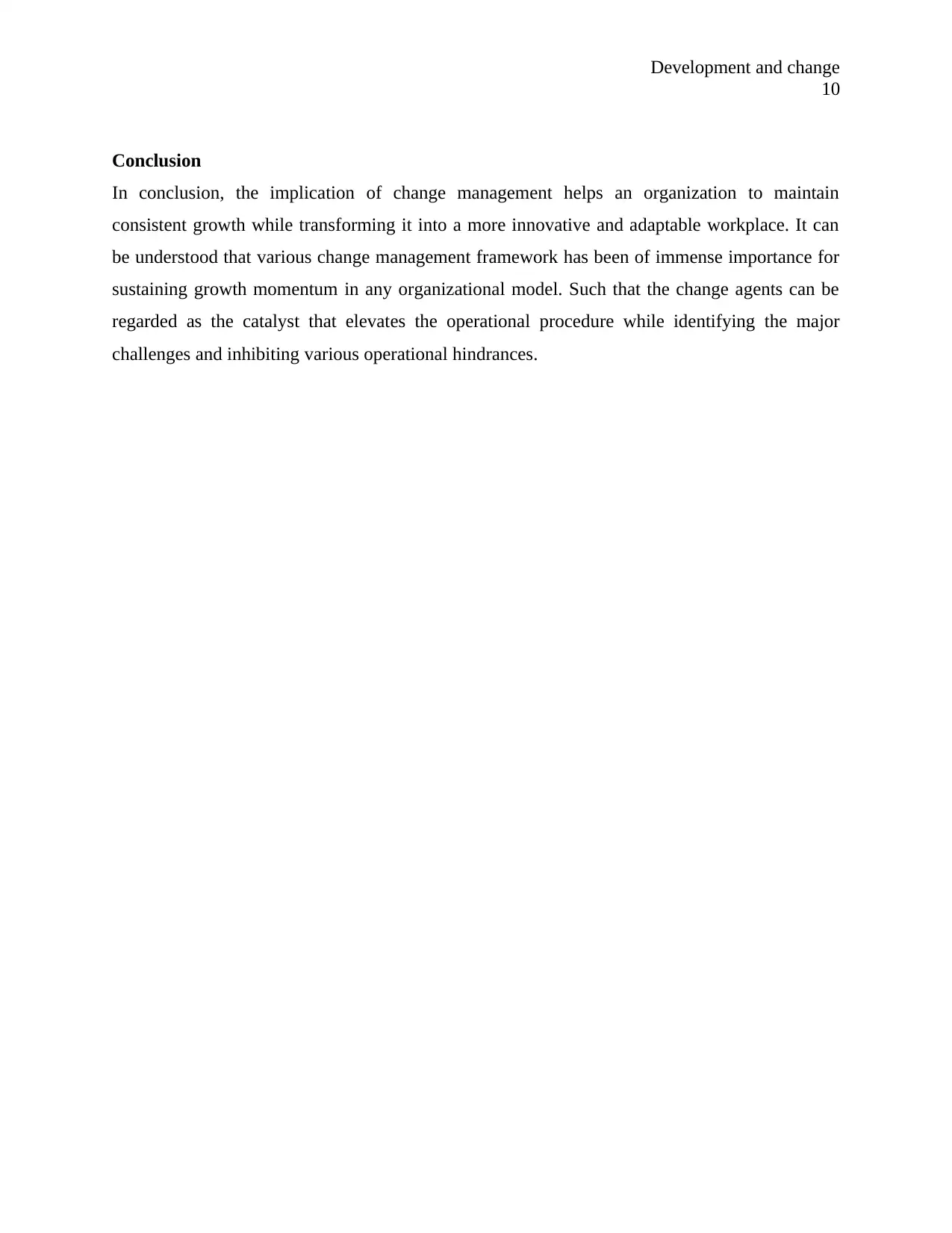
Development and change
10
Conclusion
In conclusion, the implication of change management helps an organization to maintain
consistent growth while transforming it into a more innovative and adaptable workplace. It can
be understood that various change management framework has been of immense importance for
sustaining growth momentum in any organizational model. Such that the change agents can be
regarded as the catalyst that elevates the operational procedure while identifying the major
challenges and inhibiting various operational hindrances.
10
Conclusion
In conclusion, the implication of change management helps an organization to maintain
consistent growth while transforming it into a more innovative and adaptable workplace. It can
be understood that various change management framework has been of immense importance for
sustaining growth momentum in any organizational model. Such that the change agents can be
regarded as the catalyst that elevates the operational procedure while identifying the major
challenges and inhibiting various operational hindrances.
Paraphrase This Document
Need a fresh take? Get an instant paraphrase of this document with our AI Paraphraser
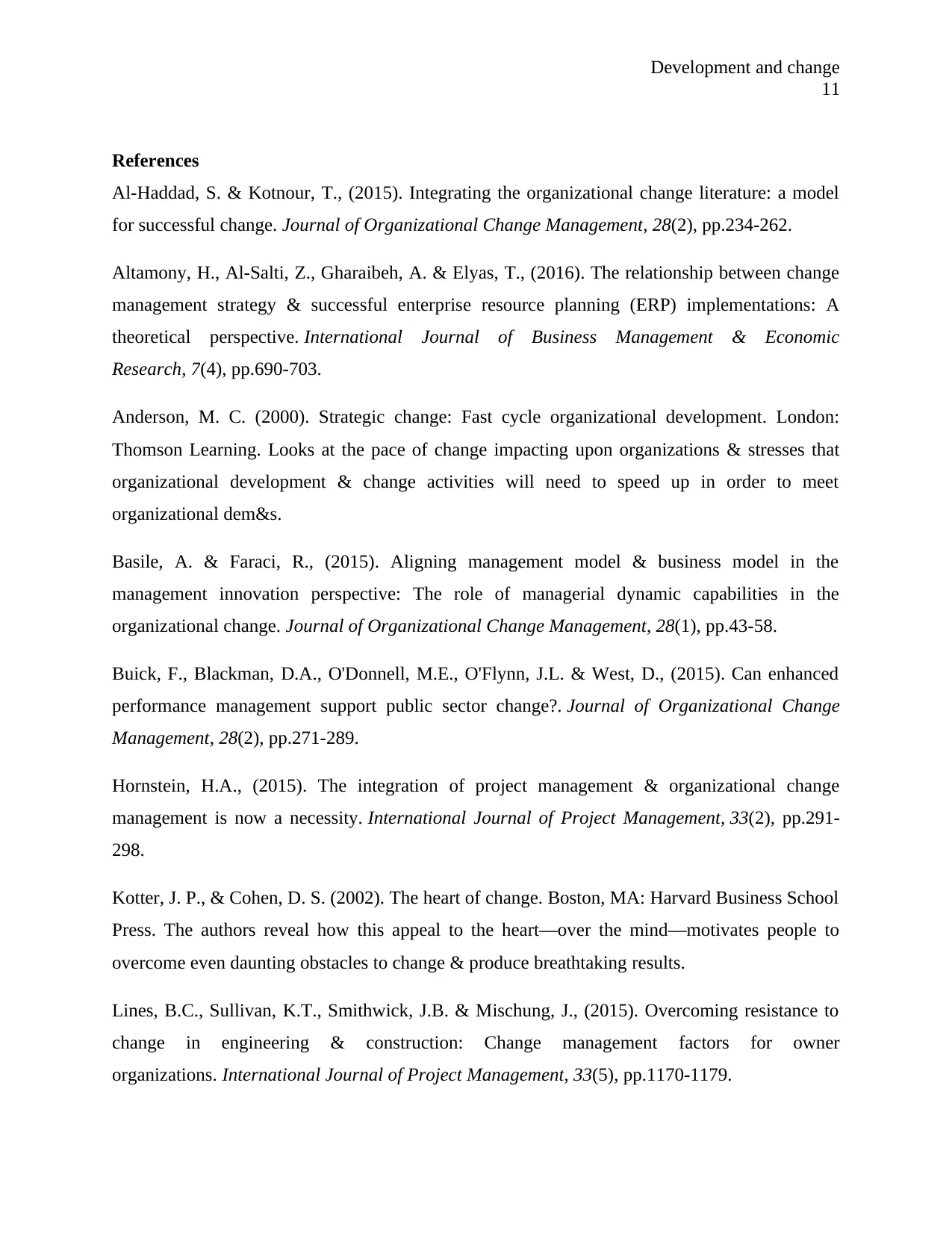
Development and change
11
References
Al-Haddad, S. & Kotnour, T., (2015). Integrating the organizational change literature: a model
for successful change. Journal of Organizational Change Management, 28(2), pp.234-262.
Altamony, H., Al-Salti, Z., Gharaibeh, A. & Elyas, T., (2016). The relationship between change
management strategy & successful enterprise resource planning (ERP) implementations: A
theoretical perspective. International Journal of Business Management & Economic
Research, 7(4), pp.690-703.
Anderson, M. C. (2000). Strategic change: Fast cycle organizational development. London:
Thomson Learning. Looks at the pace of change impacting upon organizations & stresses that
organizational development & change activities will need to speed up in order to meet
organizational dem&s.
Basile, A. & Faraci, R., (2015). Aligning management model & business model in the
management innovation perspective: The role of managerial dynamic capabilities in the
organizational change. Journal of Organizational Change Management, 28(1), pp.43-58.
Buick, F., Blackman, D.A., O'Donnell, M.E., O'Flynn, J.L. & West, D., (2015). Can enhanced
performance management support public sector change?. Journal of Organizational Change
Management, 28(2), pp.271-289.
Hornstein, H.A., (2015). The integration of project management & organizational change
management is now a necessity. International Journal of Project Management, 33(2), pp.291-
298.
Kotter, J. P., & Cohen, D. S. (2002). The heart of change. Boston, MA: Harvard Business School
Press. The authors reveal how this appeal to the heart—over the mind—motivates people to
overcome even daunting obstacles to change & produce breathtaking results.
Lines, B.C., Sullivan, K.T., Smithwick, J.B. & Mischung, J., (2015). Overcoming resistance to
change in engineering & construction: Change management factors for owner
organizations. International Journal of Project Management, 33(5), pp.1170-1179.
11
References
Al-Haddad, S. & Kotnour, T., (2015). Integrating the organizational change literature: a model
for successful change. Journal of Organizational Change Management, 28(2), pp.234-262.
Altamony, H., Al-Salti, Z., Gharaibeh, A. & Elyas, T., (2016). The relationship between change
management strategy & successful enterprise resource planning (ERP) implementations: A
theoretical perspective. International Journal of Business Management & Economic
Research, 7(4), pp.690-703.
Anderson, M. C. (2000). Strategic change: Fast cycle organizational development. London:
Thomson Learning. Looks at the pace of change impacting upon organizations & stresses that
organizational development & change activities will need to speed up in order to meet
organizational dem&s.
Basile, A. & Faraci, R., (2015). Aligning management model & business model in the
management innovation perspective: The role of managerial dynamic capabilities in the
organizational change. Journal of Organizational Change Management, 28(1), pp.43-58.
Buick, F., Blackman, D.A., O'Donnell, M.E., O'Flynn, J.L. & West, D., (2015). Can enhanced
performance management support public sector change?. Journal of Organizational Change
Management, 28(2), pp.271-289.
Hornstein, H.A., (2015). The integration of project management & organizational change
management is now a necessity. International Journal of Project Management, 33(2), pp.291-
298.
Kotter, J. P., & Cohen, D. S. (2002). The heart of change. Boston, MA: Harvard Business School
Press. The authors reveal how this appeal to the heart—over the mind—motivates people to
overcome even daunting obstacles to change & produce breathtaking results.
Lines, B.C., Sullivan, K.T., Smithwick, J.B. & Mischung, J., (2015). Overcoming resistance to
change in engineering & construction: Change management factors for owner
organizations. International Journal of Project Management, 33(5), pp.1170-1179.
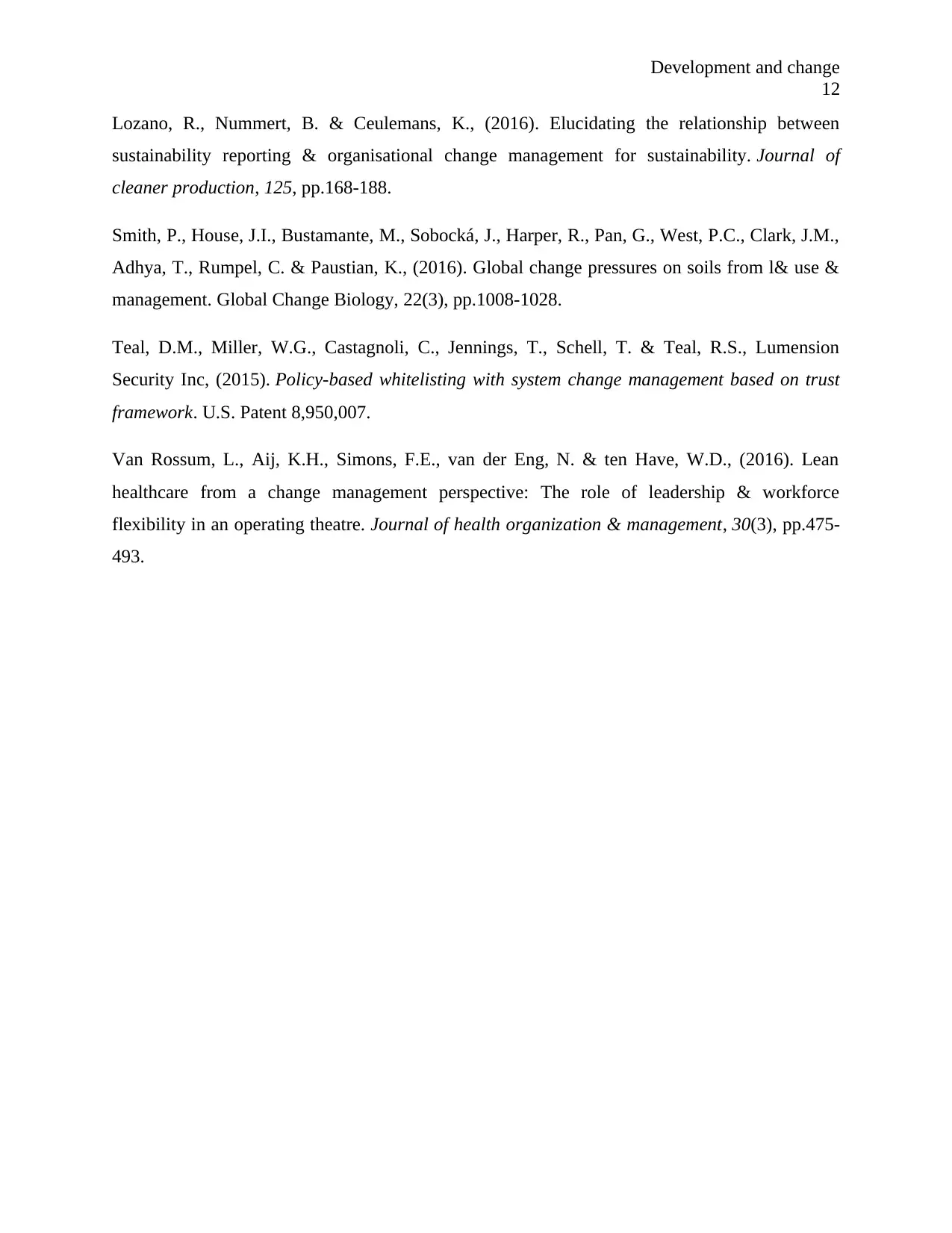
Development and change
12
Lozano, R., Nummert, B. & Ceulemans, K., (2016). Elucidating the relationship between
sustainability reporting & organisational change management for sustainability. Journal of
cleaner production, 125, pp.168-188.
Smith, P., House, J.I., Bustamante, M., Sobocká, J., Harper, R., Pan, G., West, P.C., Clark, J.M.,
Adhya, T., Rumpel, C. & Paustian, K., (2016). Global change pressures on soils from l& use &
management. Global Change Biology, 22(3), pp.1008-1028.
Teal, D.M., Miller, W.G., Castagnoli, C., Jennings, T., Schell, T. & Teal, R.S., Lumension
Security Inc, (2015). Policy-based whitelisting with system change management based on trust
framework. U.S. Patent 8,950,007.
Van Rossum, L., Aij, K.H., Simons, F.E., van der Eng, N. & ten Have, W.D., (2016). Lean
healthcare from a change management perspective: The role of leadership & workforce
flexibility in an operating theatre. Journal of health organization & management, 30(3), pp.475-
493.
12
Lozano, R., Nummert, B. & Ceulemans, K., (2016). Elucidating the relationship between
sustainability reporting & organisational change management for sustainability. Journal of
cleaner production, 125, pp.168-188.
Smith, P., House, J.I., Bustamante, M., Sobocká, J., Harper, R., Pan, G., West, P.C., Clark, J.M.,
Adhya, T., Rumpel, C. & Paustian, K., (2016). Global change pressures on soils from l& use &
management. Global Change Biology, 22(3), pp.1008-1028.
Teal, D.M., Miller, W.G., Castagnoli, C., Jennings, T., Schell, T. & Teal, R.S., Lumension
Security Inc, (2015). Policy-based whitelisting with system change management based on trust
framework. U.S. Patent 8,950,007.
Van Rossum, L., Aij, K.H., Simons, F.E., van der Eng, N. & ten Have, W.D., (2016). Lean
healthcare from a change management perspective: The role of leadership & workforce
flexibility in an operating theatre. Journal of health organization & management, 30(3), pp.475-
493.
⊘ This is a preview!⊘
Do you want full access?
Subscribe today to unlock all pages.

Trusted by 1+ million students worldwide
1 out of 12
Related Documents
Your All-in-One AI-Powered Toolkit for Academic Success.
+13062052269
info@desklib.com
Available 24*7 on WhatsApp / Email
![[object Object]](/_next/static/media/star-bottom.7253800d.svg)
Unlock your academic potential
Copyright © 2020–2025 A2Z Services. All Rights Reserved. Developed and managed by ZUCOL.




